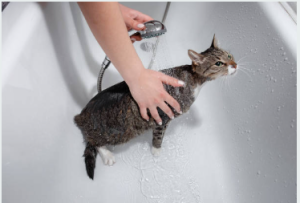How To Bath A Cat: A Comprehensive Guide
Cats are generally clean animals and groom themselves regularly. However, there are times when your cat may need a bath, such as if they have gotten into something dirty or have a medical condition that requires bathing.
Bathing a cat can be challenging, but it is possible with patience and preparation. Here is a comprehensive guide on how to clean a cat:
Step 1: Gather your supplies
Before bathing your cat, gather all your supplies in one place. This will help make the process go more smoothly and avoid unnecessary stress for your cat.
You will need:
- A sink or bathtub filled with warm water (not hot)
- A non-slip mat for the sink or bathtub
- A mild cat shampoo and conditioner
- A washcloth or sponge
- A towel
- A treat for your cat
Step 2: Prepare your cat
If possible, trim your cat’s nails before bathing them. This will help to prevent them from scratching you if they become agitated.
You may also want to brush your cat’s fur to remove any mats or tangles. This will make it easier to shampoo and rinse your cat’s skin.
Step 3: Wet your cat
Start by wetting your cat’s fur with warm water. Be careful not to get water in their ears or eyes.
You can use a handheld sprayer, a pitcher, or a cup to wet your cat’s fur. Be gentle and avoid spraying them in the face.
Step 4: Apply shampoo
Once your cat’s fur is wet, apply a small amount of cat shampoo to their back. Massage the shampoo into their fur, working your way down to their tail.
Avoid getting shampoo in your cat’s ears, eyes, and nose. If you get shampoo in these areas, rinse it immediately with clean water.
Step 5: Rinse your cat
Once you have shampooed your cat’s fur, rinse it thoroughly with warm water. Make sure to rinse all of the shampoos out of their fur.
You may need a washcloth or sponge to help rinse your cat’s fur.
Step 6: Apply conditioner
If desired, apply a small amount of cat conditioner to your cat’s fur after rinsing the shampoo. This will help to soften their fur and prevent it from becoming matted.
Rinse the conditioner out of your cat’s fur thoroughly.
Step 7: Dry your cat
Once your cat is rinsed, wrap them in a towel and dry them off. You can also use a hair dryer on a low setting to dry your cat’s fur.
Be careful not to overheat your cat.
Step 8: Reward your cat
Once your cat is dry, please treat them to reward them for being good.
Tips for bathing a cat
Here are some suggestions for bathing a cat:
- Bathe your cat in a quiet place where they feel comfortable.
- Be gentle and patient.
- Use warm water, not hot water.
- Avoid getting water in your cat’s ears, eyes, and nose.
- Use a mild cat shampoo and conditioner.
- Rinse your cat thoroughly.
- Dry your cat off with a towel.
- Reward your cat for being good.
How often to bathe a cat
Most cats do not need to be bathed more than once a month or two. However, if your cat has gotten into something dirty or has a medical condition that requires bathing, you may need to bathe them more often.
If your cat dislikes water
If your cat dislikes water, there are a few things you can do to make the bathing experience more pleasant for them:
- Start by wetting your cat’s fur with a damp washcloth. This will help them to get used to the feeling of water on their fur.
- Use a handheld sprayer or pitcher to wet your cat’s fur, rather than dunking them in the water.
- Apply the shampoo to your cat’s fur with a washcloth or sponge.
- Rinse your cat’s fur thoroughly with a damp washcloth or sponge.
- You can also try bathing your cat in a sink or basin, rather than a bathtub. This may make them feel more relaxed.
If you are unable to bathe your cat yourself
If you cannot bathe your cat, you can take them to a professional groomer. Professional groomers have the experience and expertise to wash cats safely and gently.
Conclusion
Bathing a cat can be challenging, but it is possible with patience and preparation. Following the tips in this guide can make the bathing experience more pleasant for your cat and yourself.
**Additional tips



